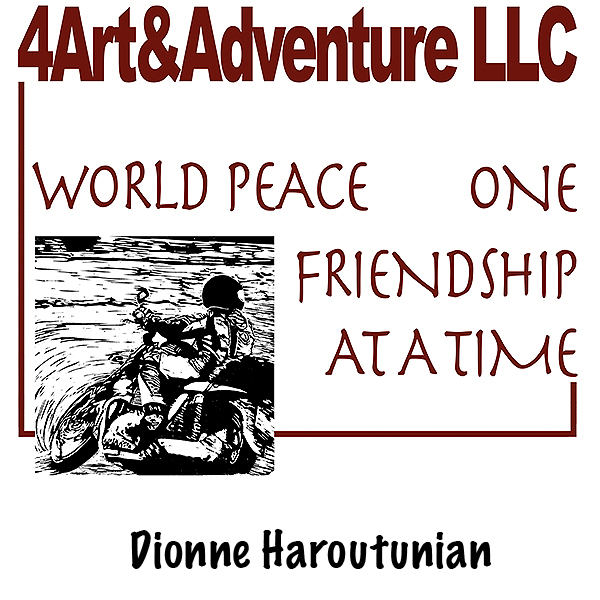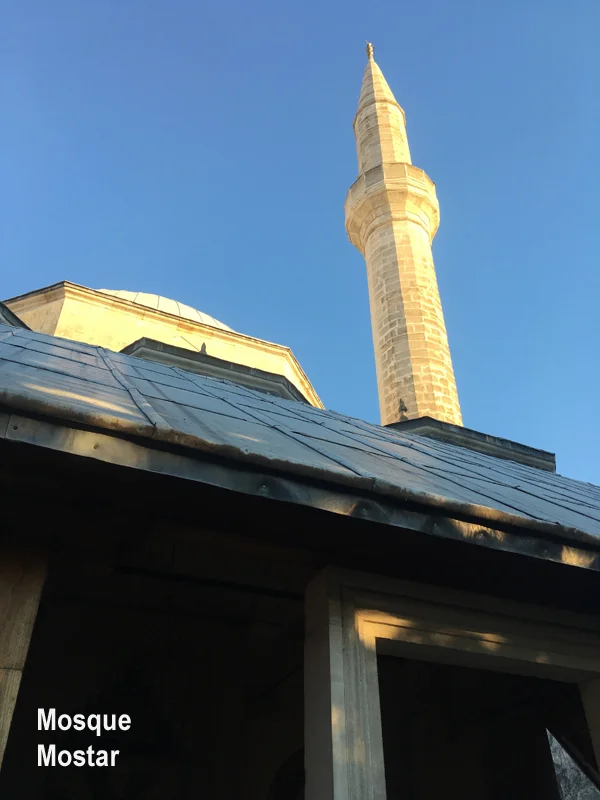After doing as much research as we can online, we finally get an address and a little information about Tito’s Partisan Cemetery…
Read moreBOSNIA, PART 7: TITO’S PARTISAN CEMETERY OF MOSTAR (1 OF 3)
Among dozens of quick stops during his tour (the kind where nobody gets off the bus) Bata pulls on the sidewalk and points to an unattractive area on the other side of the street. Honestly it doesn’t look like much at all…
Read moreBOSNIA, PART 6: BATA (3 OF 3)
After the waterfalls, the pace eases a little. He remains a torrent of information and personal stories but he includes sites and topics that are not…
Read moreBOSNIA, PART 5: BATA (2 OF 3)
La version française est en cours de traduction. Merci de votre patience.
Our introduction into the harsh reality of Mostar is immediate. I might even call it abrupt!
The highway we used so innocently the day before, turns out to mark a division between two territories. East for Bosniaks, West for Croats. Bata took the time to make sure we understood that both are Bosnians. The Croat side is rich; fewer ruins; several modern shopping centers and hotels. Even a McDonald’s. Bata drives us back and forth between the two and gives us an overview of both sides; several important buildings that were destroyed and the secrets they hold. The City Bath with its Olympic size swimming pool where Bosniaks have to wait months for a ½ hour training session.
The Music School with its new 2MIO euros façade and rotten interiors. The ghost of a shopping center with its impressive bas-relief motifs inspired by Bosnia’s early mythology: it lost its eight floors of apartments to a bomb. The 25000 seat Croat-controlled Stadium where the Bosniak team is not allowed. The street plaques painted over and renamed with Croatian names (thus rendering our map unusable). The University where the language of admission is Croatian. The high school, used as an example of children being educated together when in fact, Bosniaks and Croats are kept apart. The elderly who are reduced to dumpster-diving to augment their meager pensions. The city parks which, except for two, were all turned into cemeteries. I went back the next day: without fail the tumbstones bear the same death year. The Promenade where young single people would parade and try to find a mate. As Bata’s story goes, the men were so busy acting like peacocks that the women all left and got married elsewhere, thus leaving a slew of older single guys behind – they’re still on the promenade today, sipping their beer in hopes of finding the right woman. We saw them!
The information doesn’t just rain on us. It’s a deluge. It is not organized like a nice history book. Clean and unemotional. Architecture and historical information are mixed with painful details of the on-going consequences of war in every-day life for Bosnians. Nothing one will ever read in a guidebook.
A couple of hours later, it’s time for an abrupt change of pace! Bata jumps on the main road and heads out of town at the speed of light. He is taking us to the Kravice Waterfalls. As we get out of Bella, he says now we rest, we don’t speak about history anymore. We relax. Have fun. Swim. Eat. Drink.
The break is welcome. For him as well as for us. Bata gives it all he’s got. He must be exhausted. Personally at that moment I am thinking that the ten-hour tour is just a name … who would ever really do that? It’s crazy. So I’m preparing myself for the inevitable: the return to Mostar after the Falls. Wrong – woman of little faith. I really didn’t know or understand the Bata phenomenon!
There is as much to come as we have already experienced …
BOSNIA, PART 4: BATA (1 OF 3)
La version française est en cours de traduction. Merci de votre patience.
As I am sitting there, enjoying my conversation with a dozen of Majda’s Youth Hostel guests, I am reminded of my trip around the world when I too was 20. Suddenly I hear a loud gregarious voice outside “BACKPACKERS LET’S GO C’M’ON TAKE YOUR STUFF LET’S GO HA HA HA.” I waited three months, flew from Seattle to Geneva, rode my motorcycle 3000 km to Mostar to meet him: the man who gives a ten-hour tour focused on what really happened during the Bosnian War.
High energy and self described as completely crazy: meet Bata! Intense. Loud. Passionate. Forthright. Enthusiastic. Playful. Unapologetic. A force of nature.
Underneath it all, extraordinarily caring.
TWO VOLUNTEERS. C’M’ON BACKPACKERS … WHO WILL IT BE? WHO WILL IT BE?
Mike and I raise our hands. He burst out laughing YOU SEE PEOPLE? THESE TWO THEY RAISED THEIR HANDS JUST LIKE THAT… SO THEY GET TO SIT IN THE BACK ON PLASTIC CHAIRS! And so it goes that the “old folks” spend the rest of the day tossed in every direction on unattached garden chairs, bracing themselves against windows, ceiling, floor and the seat in front of them. We definitely got the best spot!
Let me say from the outset: this blog is in no way a political exposé of the events that took place in Mostar. For starters, the history of this area is incredibly complicated. I did a lot of research and at first I couldn’t even understand what I was reading! But just to give a general reference: Mostar is known to be the most heavily bombed of any Bosnian cities during the 1992-1995 war following the break-up of Yugoslavia.
Unlike Sarajevo, the West never came to help.
Mostar’s Old Town was completely destroyed, including its architectural and spiritual heart, Stari Most, the Old Bridge, lovingly nicknamed GrandPa. This war was waged on civilians. From the surrounding hills and high buildings, snipers aimed at people indiscriminately; they filled truck tires with dynamite and rolled them down the hill into the homes of Bosniak families. The list of atrocities is endless and we are about to be exposed to the legacy it has left and how this legacy is shaping people’s lives today.
Filled to the rim, Bella IV (the van, also known as Bata’s girlfriend) enthusiastically joins the crazy Bosnian traffic. If the road is blocked, qu’à cela ne tienne, we will use the sidewalks. Nothing will stop us — we will swerve, weave, use one-way streets in reverse direction. We are with Bata. We are invincible!
Little do I know that I am just about to have the experience of a lifetime…
If you enjoyed this post and would like to become a part of the worldwide community I am building, you can join a long list of supporters and purchase a piece of art. A heartfelt thank you to all of you who have chosen to support my project and “come with me" in recent years.
BOSNIA, PART 3: MAJDA
La version française est en cours de traduction. Merci de votre patience.
I’m sitting on a patio, in the midst of beautiful flowers, having great conversations with a group of 30 year olds while enjoying a delicious breakfast. I am in awe: I AM IN MOSTAR! On April 25 my friend Jane said go to Mostar, find Majda and her brother Bata: they give a ten-hour tour on what really happened during the Bosnian War. I have been waiting impatiently for this moment.
Majda radiates Calm. Peace. She is gentle soft-spoken caring thoughtful. Although she never stops moving – there is a lot of work – her movements are deliberate and serene. She is the benevolent Queen of Majda Hostel. She works the myriad details necessary for making this the remarkable place that it is: overflowing with life, with happiness and love.
Life. Happiness. Love: the three ingredients that were violently taken away from her family with the onset of the 1992-1995 Bosnian War. To survive, Majda left for England as an au pair, where she spent four very lonely years in a constant state of fear and uncertainty; Bata left Mostar disguised as an ambulance patient and lived in Sweden for fourteen years; their parents took refuge in Norway.
A few years after the war, Majda and her parents moved back to Bosnia. On his way over for a visit, Bata meets some backpackers on the plane and brings them home and the family takes care of them. That’s when a plan is hatched: they will turn one room in their home into a guest room. Although Bosnia is fresh out of the war and still in a complete state of disarray, there are people, much to the family’s surprise, who want to come and understand what happened. The world had let Mostar down: it simply watched and listened without making a move.
Over time, one room turns into two. Then three. Pretty soon the family lives in one room and the house becomes a youth hostel. Mom works hard alongside her children. Majda says the Guesthouse became her salvation. It brought meaning back into her life and with it, the chance to share both her country’s recent pain and its extensive culture. Bata takes guests on tours and gives them the “straight story.” For the past eleven years, every morning as the next group gathers, Majda shares her story and that of her family. She shows her friend’s video clip of their beloved Stari Most (old bridge), affectionately nicknamed “grandpa,” being bombed in 1995 by the Croats.
I am spellbound. Each word falls inside of me like a tiny piece of lead. Why didn’t the world do something? And what was I doing in 1992? I was reading the papers: what did I think? Did I simply turn the page? Did I cry? How can this happen — again?
Over the years this Bosniak family has educated thousands of people and sent them back into the world with a deep understanding of Bosnia, past and present, and their culture. They have gifted each single one of us with something rare and infinitely precious: a glimpse behind the curtain that separates a visitor from a local; a “guest” from a friend.
If you enjoyed this post and would like to become a part of the worldwide community I am building, you can join a long list of supporters and purchase a piece of art. A heartfelt thank you to all of you who have chosen to support my project and “come with me” over the years.














![06_3586[w].jpg](https://images.squarespace-cdn.com/content/v1/5ab7eb8931d4df2d435dd0eb/1529451143089-8YYILUC3OU4RO81UHTJH/06_3586%5Bw%5D.jpg)



![04_3602[w].jpg](https://images.squarespace-cdn.com/content/v1/5ab7eb8931d4df2d435dd0eb/1529450309326-VS8PJFXXJBJ07C6KYMK8/04_3602%5Bw%5D.jpg)

